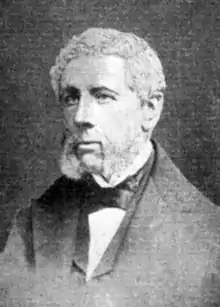Daniel Mac Carthy Glas
Daniel Mac Carthy (Glas) (Irish Dónaill Mac Cárthaigh; 28 June 1807 – 9 April 1884) was an author of historical fiction, Irish history and biography, born in London of Irish descent. Mac Carthy was in correspondence with a large circle of archaeologists, antiquarians and early pioneers of Irish scholarship during the Irish historical awakening of the 19th century, as evidenced in letters found in collections such as the Royal Irish Academy and Cork City and County Archives.[1][2][3][4]
Daniel Mac Carthy Glas | |
|---|---|
 | |
| Born | 28 April 1807 London, United Kingdom |
| Died | 9 April 1884 Southampton, United Kingdom |
| Education | St. Edmund's, Old Hall Green, Hertfordshire |
| Occupation | Author and historian |
| Years active | 1840 – 1880 |
Notable work | (i) The Life and Letters of Florence MacCarthy Reagh, Tanist of Carbery, MacCarthy Mór (ii) A Historical Pedigree of the Sliochd Feidhlimidh, the MacCarthys of Gleannacroim |
| Spouse(s) | Harriet Alexandrina Bassett Popham (1804 – 1847) |
| Parent(s) | Daniel Mac Carthy and Mary Anne Ward |
Life
Mac Carthy was born into an Irish shipping and coal merchant family of Wellclose Square, East London.[1] After receiving his education at the Roman Catholic school, St. Edmund's College, he resided a number of years on the continent; where in Naples, at the age of 25, he married the daughter of Admiral Sir Home Popham. Together they had a daughter and two sons, of which only one outlived Mac Carthy.
Being of independent means, Mac Carthy initially focused his interest in producing historic novels, which included The Siege of Florence, Massaniello and The Free Lance. In 1867, Mac Carthy published his first scholarly work, The Life and Letters of Florence MacCarthy Reagh, which details the biography of kinsman Florence Mac Carthy Reagh (1560 – 1640). This was followed by a second work in 1875, A Historical Pedigree of the Sliochd Feidhlimidh, the Mac Carthys of Gleannacroim, which documents the genealogy of numerous members of a west Cork sept of the Mac Carthy Clan, from whom he claimed ancestral descent.[5][6]
In the course of his genealogical research, Mac Carthy established links to his paternal family's homeplace of Dunmanway. He gave generously to many causes in the district, including the education of children.[7][8] However, the failure of the Overend and Gurney Bank in 1866 reduced Mac Carthy's income. His scheme to buy out his ancestral property in the neighbourhood of Dunmanway, including the castle at Togher was never fulfilled.[1][3]
Genealogy
Daniel's paternal grand-uncle Denis emigrated from Dunmanway in the mid-1700s, and became a prosperous shipowner and coal merchant in London. Mac Carthy's first cousin was Sir Charles Justin MacCarthy, Governor of Ceylon, and son-in-law of Sir Benjamin Hawes.
Mac Carthy traced his ancestry to the Lords of Gleannacroim, cousins of the Mac Carthy Reagh sept, and adopted the "Glas" agnomen earlier associated with that sept to his name.[5] However, as a result of a direct male descendant of Mac Carthy partaking in a Y-DNA study, Mac Carthy's paternal genetic origins have been shown to differ from those described in his genealogical work.[9]
Daniel Mac Carthy (Glas) Archive
In 2017, approximately 2,000 documents assembled from Mac Carthy's research and family memorabilia were donated to the Cork City and County Archive by his descendants based in the USA.[7] These include a 1784 family pedigree compiled by John Collins of Myross, which has been described as of “immense cultural and historical significance”, as well as a rare copy of a 1567 map of ‘Hibernia’ by John Goghe.[2]
References
- Coleman, James (1896). "Contributions to Irish Biography. No. 31: Daniel MacCarthy (Glas)". The Irish Monthly. 24 (278): 410–418. ISSN 2009-2113. JSTOR 20499008.
- Tuesday; May 16; 2017 (2017-05-16). "Centuries of 'lost' MacCarthy lore returned". www.irishexaminer.com. Retrieved 2020-05-24.CS1 maint: numeric names: authors list (link)
- "Graves Collection, MS 24 O 39". Royal Irish Academy. 2015-08-31. Retrieved 2020-08-14.
- O'Driscoll, Mervyn. "The MacCarthy Chieftains of Gleannacroim & Dunmanway, 1251 - 1688". Dunmanway Doings. III.
- MacCarthy, Daniel (1880). A Historical Pedigree of the Sliochd Feidhlimidh, the MacCarthys of Gleannacroim, from Carthach, Twenty-fourth in Descent from Oilioll Olum, to this Day. Exeter: W. Pollard. OCLC 561674701.
- Cronnelly, Richard Francis (1864). A History of the Clan Eoghan or Eoghanachts, Descendants of Eoghan More or Eugene the Great, Compiled from all the Accessible Sources of Irish Family History. Dublin: Good, Son, and Nethercott. OCLC 26985776.
- "Why Dunmanway is going MacCarthy mad". The Southern Star. Retrieved 2020-05-24.
- O'Donovan, Donal (2004). Fr. James Doheny, Parish Priest of Dunmanway, 1818-1848. Skibbereen: Inspire Design and Print. ISBN 0-9546345-1-9. OCLC 234118621.
- "The MacCarthy Glas Conundrum" (PDF). The MacCarthy Surname (Y-DNA) Study. 28 May 2020.